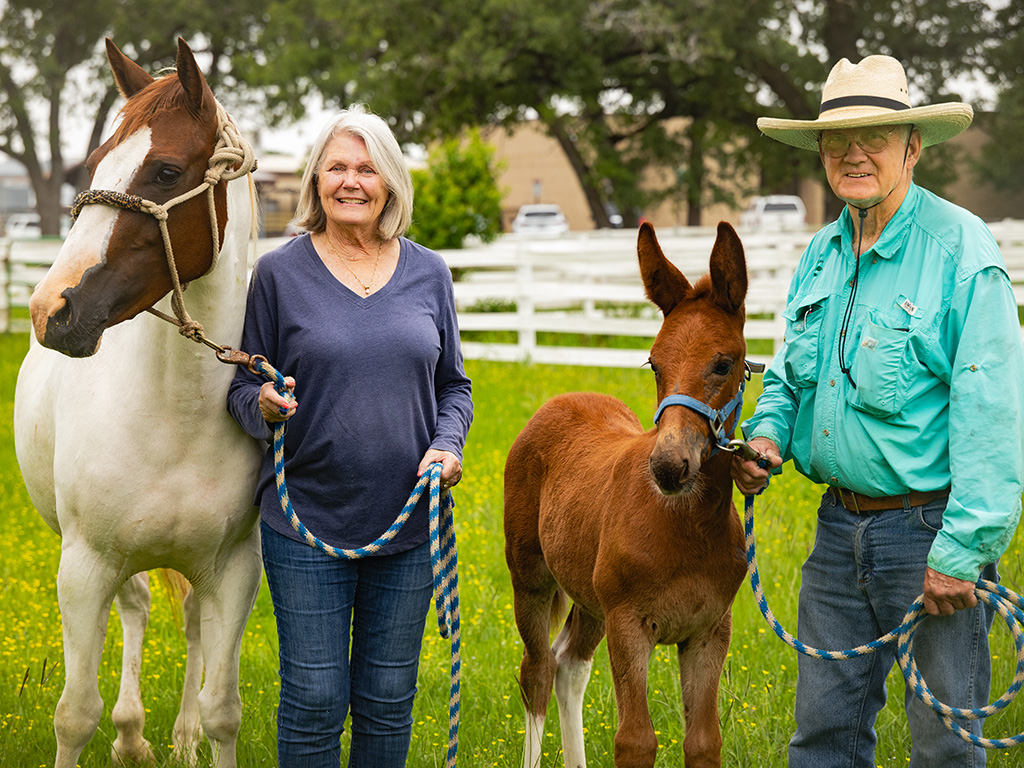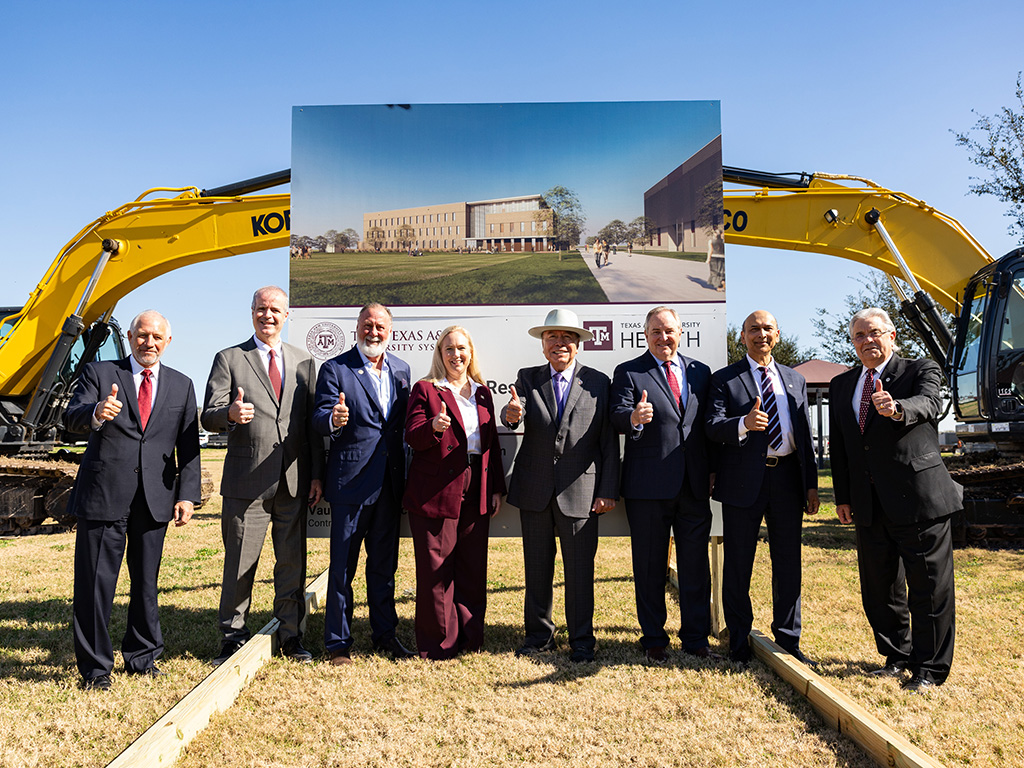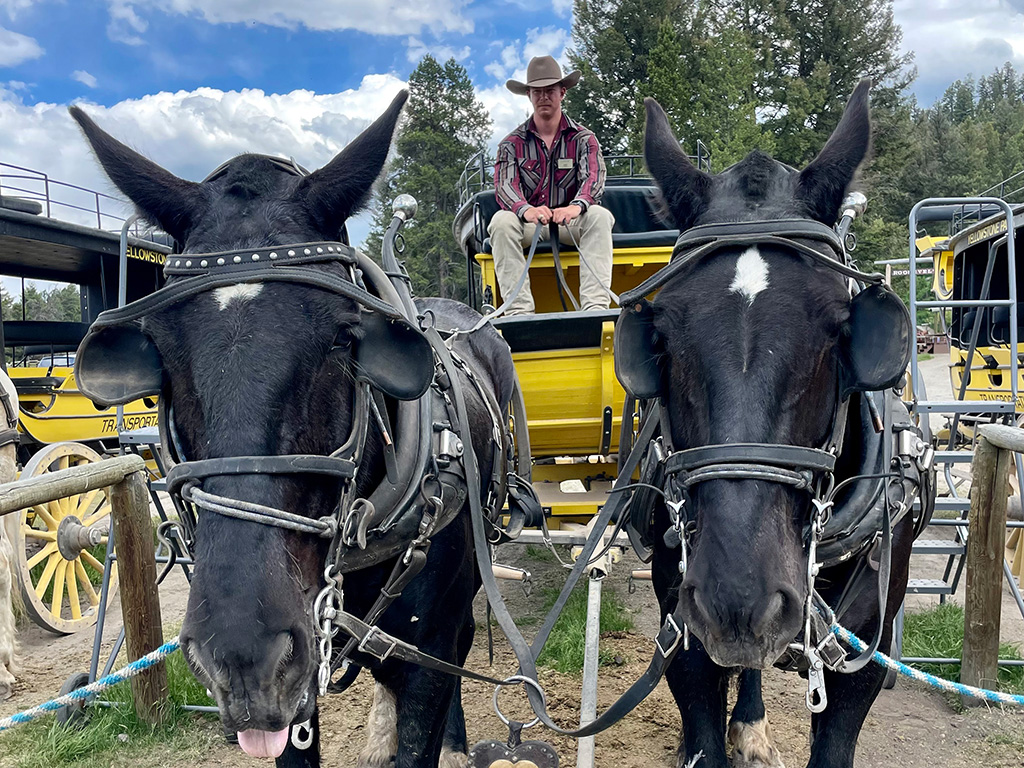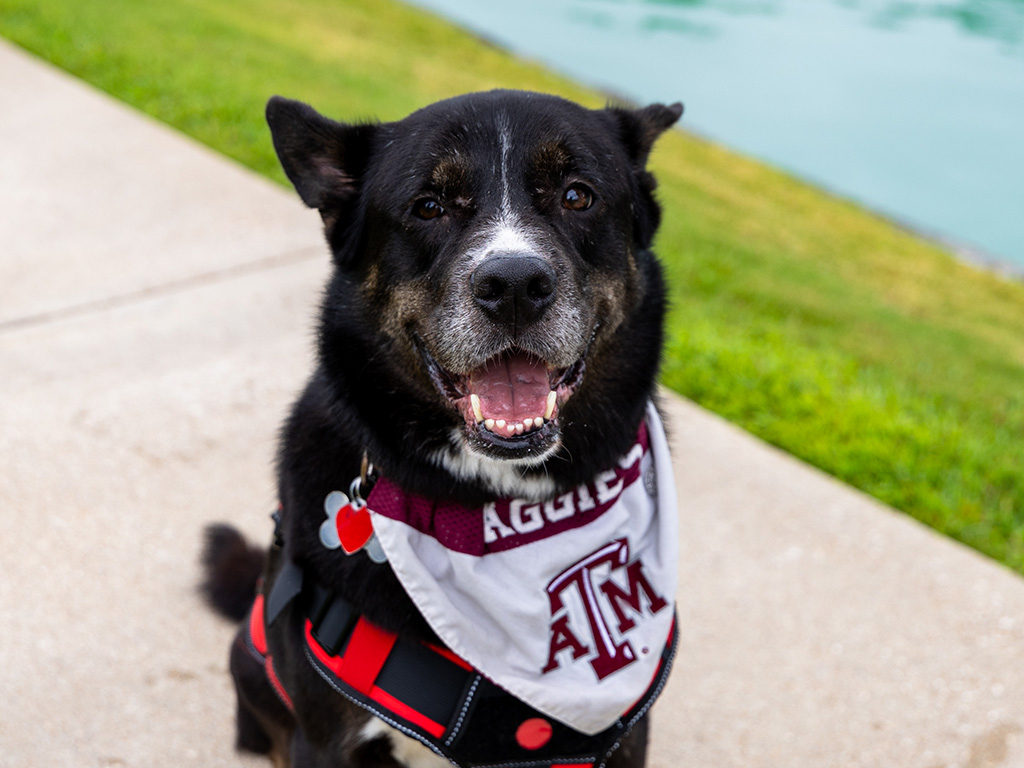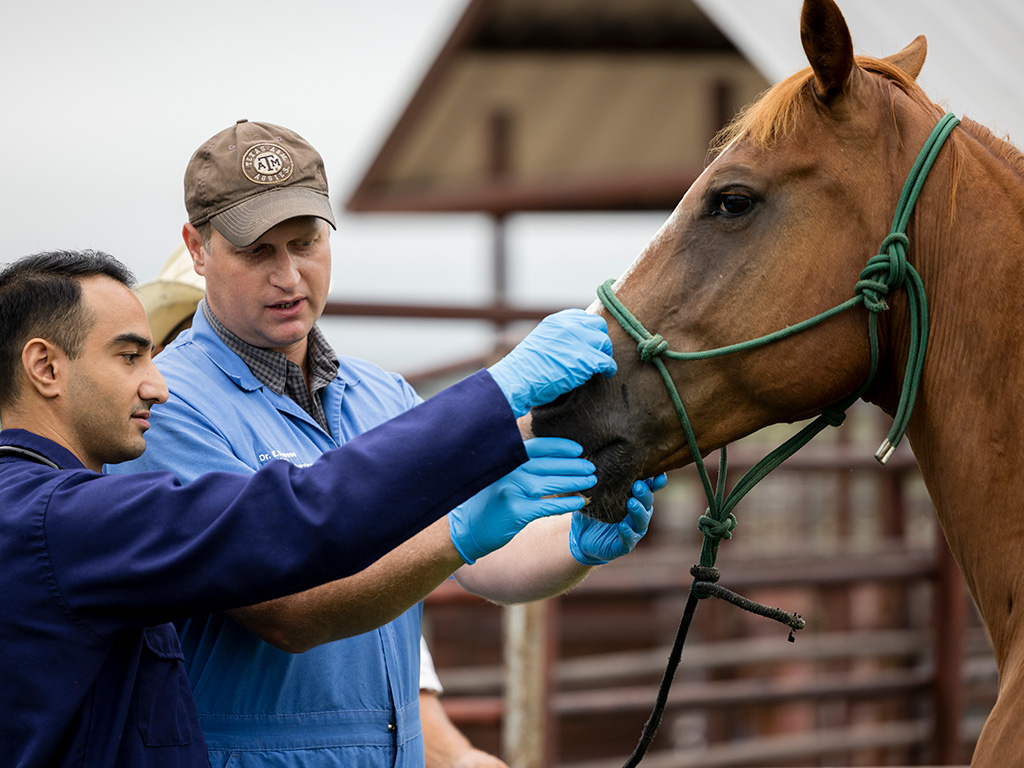Texas A&M Veterinarians Care For Baylor University Bear Mascots
Story by Megan Bennett, VMBS Marketing & Communications
Deep in the heart of Texas, two universities have formed a partnership benefitting not only students but also a very special group of American black bears.

Texas A&M and Baylor universities have historically been competitors in athletics, but there’s at least one area where the two have established a tradition of teamwork — caring for Baylor’s live American black bear mascots.
In 1917, Baylor established a tradition of supporting wildlife conservation programs when it acquired its first live bear mascots. Today, the bears live in the Association of Zoos and Aquariums-accredited Bill and Eva Williams Bear Habitat and have a team of full-time staff members and student volunteers dedicated to their care.
Veterinarians from the Texas A&M College of Veterinary Medicine & Biomedical Sciences (VMBS) have also supported the bears’ care since 2018 and were instrumental in helping now-retired mascot Judge Sue “Lady” Sloan recover from a large mass in her chest in 2019.
VMBS zoological medicine specialists continue to provide regular preventative exams for Baylor’s two black bear cubs, Judge Indy and Judge Belle, at the bears’ habitat in Waco and at the Winnie Carter Wildlife Center on Texas A&M’s campus.
A ‘Bear-y’ Rewarding Tradition
In 2018, VMBS professor emerita Dr. Sharman Hoppes received a phone call from a colleague inviting her to take over the veterinary care of Lady and Joy, Baylor’s mascots at the time. She was thrilled by the prospect of caring for the 17-year-old bears.
This new arrangement happened just in time, because Hoppes and her colleagues at the Texas A&M Veterinary Medical Teaching Hospital (VMTH) discovered a benign mass called a thymoma in Lady’s chest the following year.
“During the first geriatric exam that we brought Lady in for, we saw a mass near her heart on X-ray, and then we were able to confirm the thymoma with CT and biopsy,” Hoppes said. “The fact that we were able to bring her in for a geriatric workup probably saved her life, because we were able to pick up on the mass and deal with it before it became a clinical issue.”
Because the growing tumor was located in front of Lady’s heart and between her lungs, the VMTH veterinary team decided to treat it with stereotactic body radiation therapy using the TomoTherapy system — a course of treatment never before used on a bear.

benign thymoma. Photos by Matthew Minard, Baylor University
This method, which uses many beams of high-energy photons to deliver large doses of radiation to the tumor and spare surrounding tissues, allowed Lady to go home between treatments and avoid complications, side effects, and risks associated with surgery.
After three doses of radiation treatment, Lady’s mass was greatly reduced in size and she was able to resume her normal life in Waco. Shortly after, she was diagnosed with an unrelated spinal cyst that was fully removed with surgery.
“The treatment Judge Lady received at A&M was quite literally lifesaving in addition to being medically transformative far beyond Lady,” said Dakota Farquhar-Caddell, associate director of student activities and the Robert L. Reid Director of the Baylor Chamber of Commerce, the student organization that serves as the keeper of Baylor’s traditions, similar to the Corps of Cadets serving as keepers of the Aggie spirit. “As the treatment was the first of its kind ever done on a bear, it has raised the standard of black bear care globally.
“We cherish Lady and journeying alongside her though the process was deeply moving and inspiring,” he said. “The Texas A&M veterinary staff is unmatched and feels like an extension of our family — we were, and are, in it together.”
Today, Lady continues to receive regular veterinary care from her Texas A&M team as she lives in a “retirement home” off the Baylor campus.
“Lady’s doing quite well now,” Hoppes said. “The average life span of a captive bear is about 20 years, so she’s right up there at the very peak of longevity. She’s getting along really well, and she’s living the life of a queen.”
A New Generation
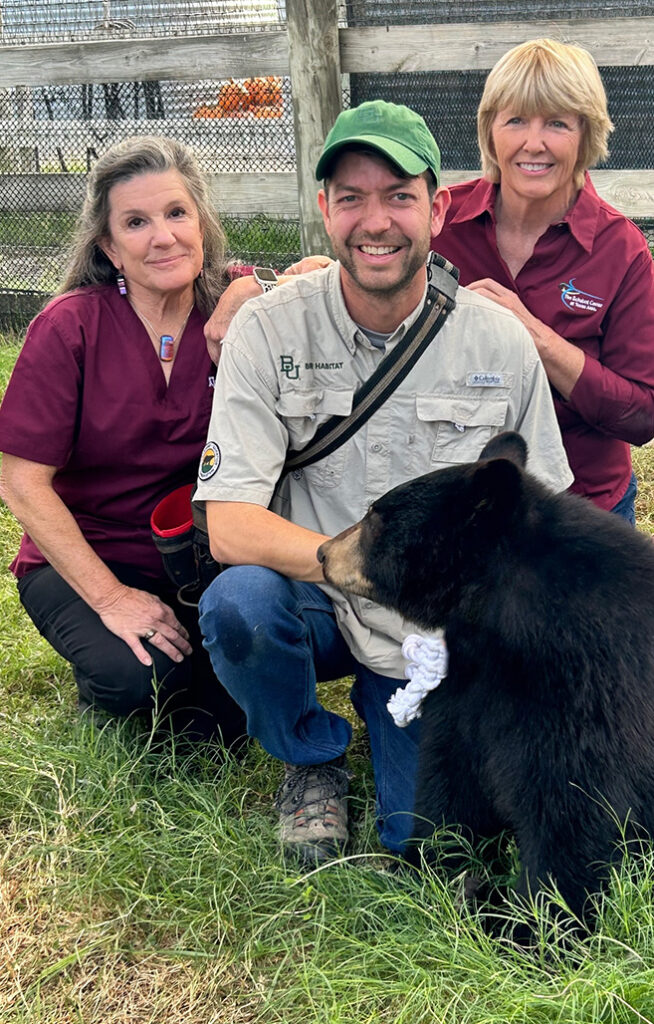
In May 2023, Baylor welcomed 3-month-old cubs Indy and Belle as the university’s newest mascots, kicking off the next chapter in the universities’ partnership.
“The cubs were rescued from a game park in Idaho where they were born in human care, which means they can never be re-released into the wild,” Farquhar-Caddell said. “Our bear habitat is designed to take in bears that have a predisposition to human-centered enrichment.”
During their time at Baylor under the care of the Texas A&M veterinary team, the bears have grown from 25 pounds to more than 150 pounds, which is still less than their eventual weight when fully grown.
“Since Indy and Belle are still young and growing really fast, we have to track exactly what we’re feeding them and how much we’re feeding them and then adjust that on a day-to-day basis,” said Jordan Wyman, a Baylor undergraduate student who works with the university’s bear program.
“What they need changes constantly, so we work with a lot of people, including their veterinarians, to make sure that the bears are always in tip-top condition.”
Regular medical exams are also an important part of maintaining the bears’ condition. Hoppes travels to Waco approximately every other week to perform general physical exams on the cubs, which include palpating the lymph nodes and abdomen; looking into the eyes, ears, and nose; and listening to the heart.
The bears also travel to College Station about once a month for a similar exam at the wildlife center.
“This helps get them used to the experience of being transported and being at the wildlife center in our large carnivore treatment center,” said Dr. Alice Blue-McLendon, a VMBS clinical associate professor and wildlife center director. “If they were to ever become ill and need to be hospitalized short-term, they could come here and it wouldn’t be as big of a shock for them.”
During their visits, the bears provide a unique learning opportunity for Texas A&M veterinary students, especially those interested in zoological, exotic, and wildlife medicine.
“This partnership is a good opportunity for our students to get the experience of working with wild animals in captive situations,” Blue-McLendon said.
Unlike domestic animals, bears and other large exotic animals often require special techniques to receive veterinary care safely, such as positive reinforcements and target training, which involves training an animal to receive veterinary exams and treatments through a fence.
“My goal is to be able to do most of our regular physical exam, vaccinations, and blood work without having to sedate them,” Hoppes said. “I’m sure it’s possible because Baylor’s No. 1 priority is to take the best care of these bears. They are a great group to work with and we’ve formed a wonderful relationship.”
Win, Win
While the partnership is great in that it provides new opportunities for veterinary students and Texas A&M clinicians, the greatest benefit is the world-class veterinary care available to the bears.
“Baylor has access to the best medical care, diagnostic equipment, and specialists,” Blue-McLendon said. “If the bears need any kind of advanced treatment in the future, we’re available to them. Any bear that gets to live at Baylor and be their mascot is one very lucky bear, because it will get the best care of any bear in the world.”
###
Note: This story originally appeared in the Fall 2024 issue of VMBS Today.
For more information about the Texas A&M College of Veterinary Medicine & Biomedical Sciences, please visit our website at vetmed.tamu.edu or join us on Facebook, Instagram, and Twitter.
Contact Information: Jennifer Gauntt, Director of VMBS Communications, Texas A&M College of Veterinary Medicine & Biomedical Sciences, jgauntt@cvm.tamu.edu, 979-862-4216
You May Also Like

